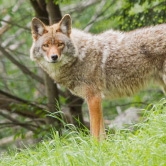
Coyote
Canis latrans
Animal Behavior: Coyotes are less likely to form packs than are wolves. Hunting, which takes place around the den, is done individually, in pairs, or in family units depending on prey availability. Coyotes are essentially nocturnal but can occasionally be seen during daylight hours. Although coyotes are capable of digging their own burrows, they often enlarge the burrows of woodchucks or badgers and use these as their dens. Dens are used year after year. There are several entrances to a single den. Coyotes leave their dens to defecate and urinate. Coyotes are capable of running at speeds up to 65 km/hr and they can jump distances of up to 4 m.
Eating Habits: Coyotes are versatile in their eating habits. They are carnivorous 90% of their diet is mammalian. They eat primarily small mammals, such as eastern cottontail rabbits, thirteen-lined ground squirrels, and white-footed mice. They occasionally eat birds, snakes, large insects and other large invertebrates. They prefer fresh meat, but they consume large amounts of carrion. Part of what makes coyotes so successful at living in so many different places is the fact that they will eat almost anything, including human trash and household pets in suburban areas.
Range: Coyotes are extremely adaptable and use a wide range of habitats including forests, grasslands, deserts, and swamps. They are typically excluded from areas with wolves. Coyotes, because of their tolerance for human activities, also occur in suburban, agricultural, and urban settings.
Conservation Efforts: Coyotes are common and widespread because of their extraordinary adaptability. Animal Facts: Coyotes are distinguished from domesticated dogs by their pointed, erect ears and drooping tail, which they hold below their back when running. The eyes have a yellow iris and round pupil. The nose is black and usually less than one inch in diameter. The ears are large in relation to the head and the muzzle is long and slender. The feet are relatively small for the size of the body. The pes has four digits and the manus has five with a small first digit. Coyotes run on their toes (digitigrade). The dental formula is 3/3 1/1 4/4 2/3. The molars are structured for crushing and the canines are rather long and slender.
